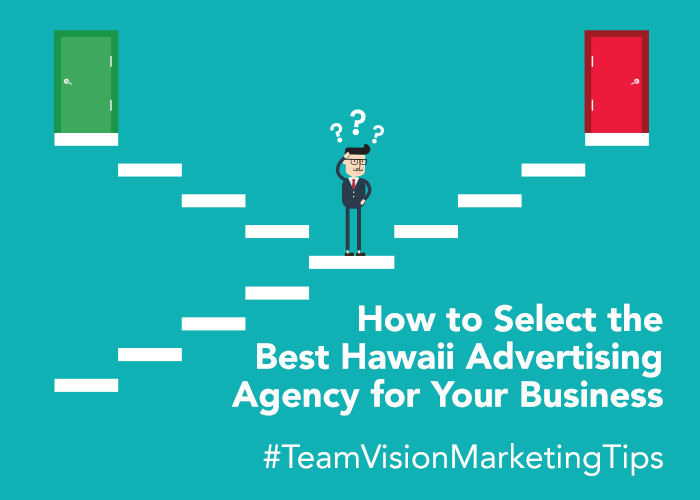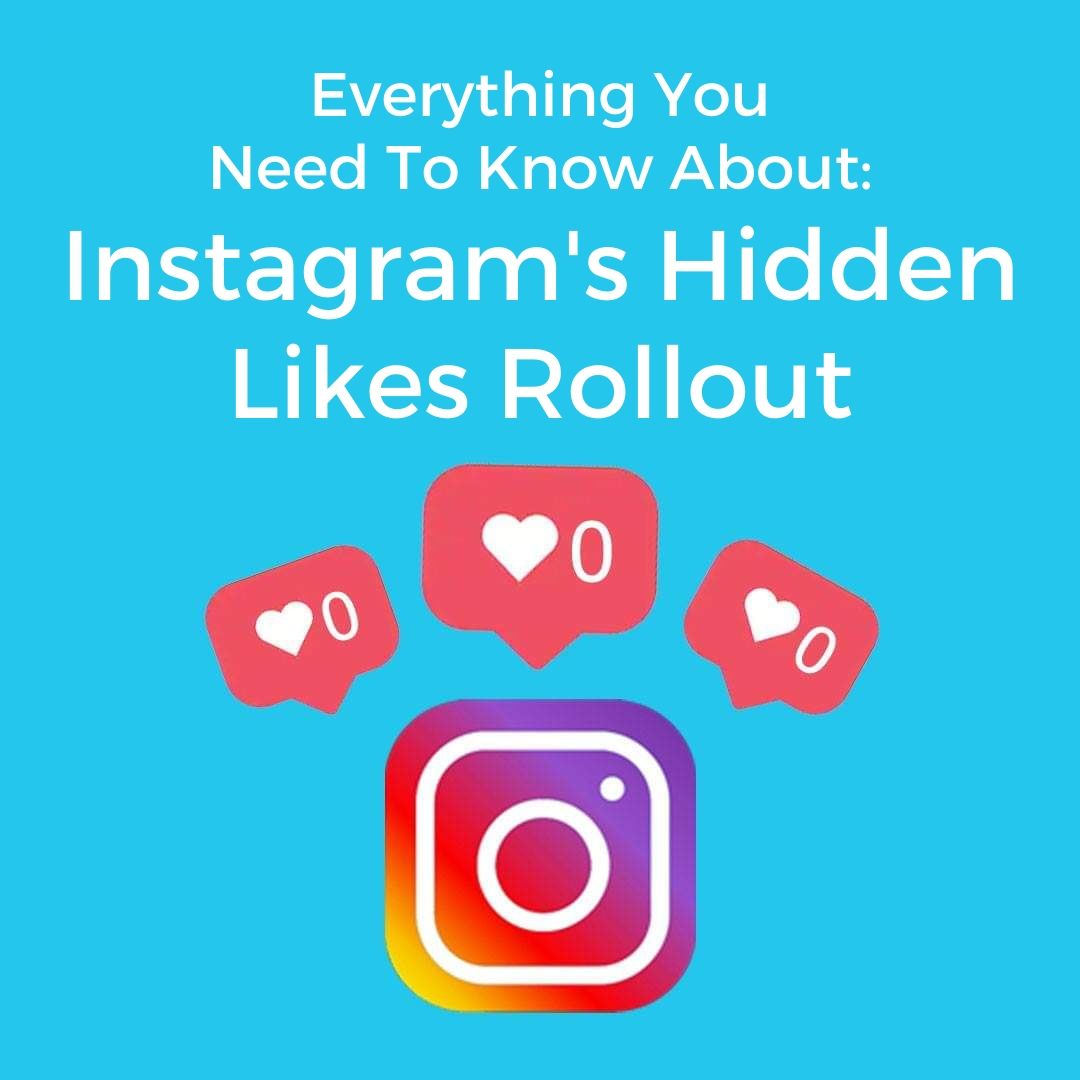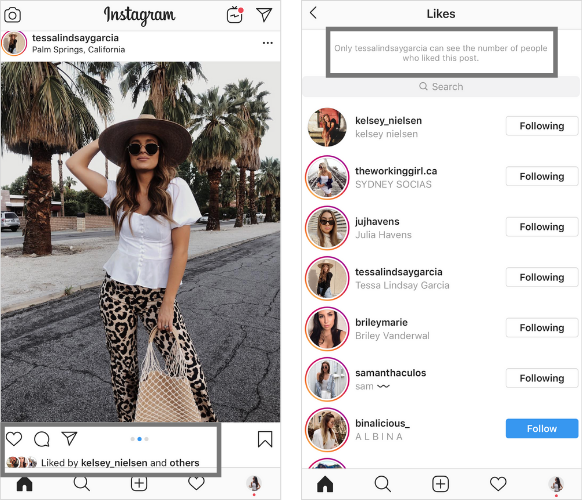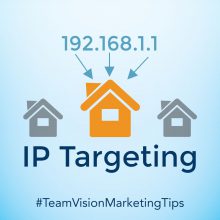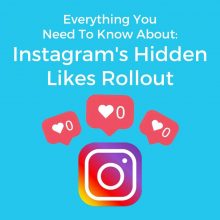If you’ve landed on our Hawaii Marketing Tips blog by accident while searching for Team Vision Marketing, please visit our homepage, creative portfolio or client video testimonials.
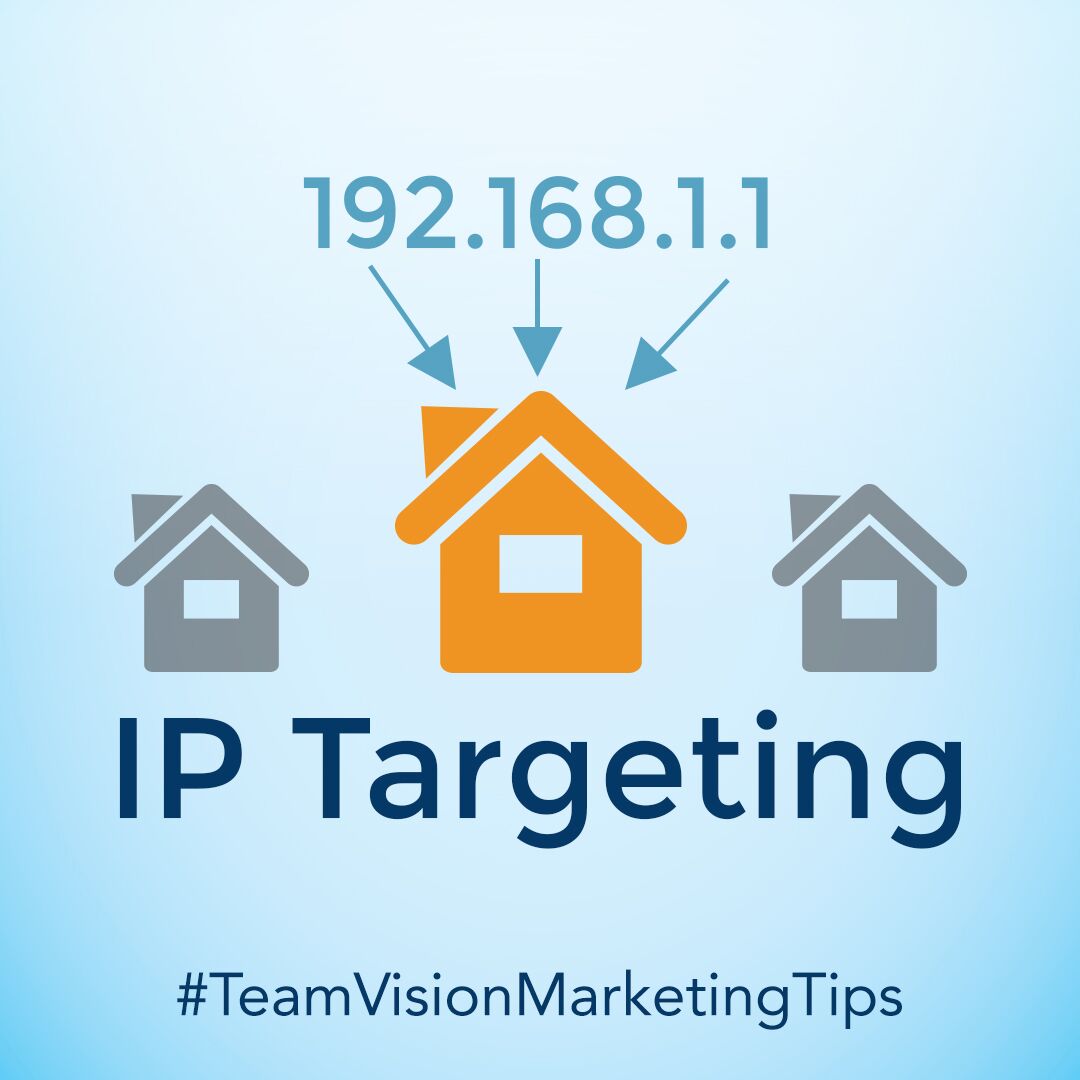
August 29, 2023
What Is IP Targeting and How Can I Use It for My Business?
If you’ve landed on our Hawaii Marketing Tips blog by accident while searching for Team Vision Marketing, please visit our homepage, creative portfolio or client video testimonials. If you’re interested in learning more about IP Targeting Campaigns, please continue reading.
IP Targeting – What Is It and Should My Business Use It?
If you’re a marketer, you’ve probably heard of IP targeting, but maybe your business or your advertising agency hasn’t yet added it to your marketing mix. This article is designed to give you an overview of what IP targeting is, explain some of the pros and cons, and give you a few examples of how you might use it for your next integrated marketing campaign.
What is IP Targeting and IP Advertising?
Here’s a quick definition for those of you who might not be familiar with IP Targeting. IP Targeting is the process of targeting digital advertising to specific households, businesses, etc. based on their Internet Protocol (IP) address. An IP address is a string of numbers assigned to your internet connection that allows you to speak with other devices on the Net.
How Does IP Targeted Advertising Work?
When a user connects to your web site, an IP address is provided for the transaction to take place. IP targeting captures that IP address, determines the location of that IP address (a home or business), and then matches that IP address against 3rd party databases of personal information. Once that IP address is captured from a web visitor, you can then conduct one-to-one marketing directly with that IP address or person. In addition, if you have customer or prospect lists with physical addresses, you can determine the IP address for homes or business locations on your target list, and then conduct digital advertising campaigns directly to those IP Addresses. Yes, there are privacy restrictions that must be met with IP targeting, but solutions to these issues have been addressed and are in place.
What are the benefits of IP Targeting?
The benefits of IP targeting over traditional cookie-based targeting is that with IP targeting you can acquire a user’s specific information. In contrast, with retargeting (or cookie-based targeting) you may never know who the actual end user is unless you get them to register or take action on your web site. To take things one step further, more recent advancements in IP targeting by certain providers now provide the ability to determine the home or business address from a user’s IP address. The additional benefit here is that you can then advertise to those prospects via digital marketing as well as printed direct mailers directly to their homes. Here again, there are privacy safeguards in place to protect the end users’ personal information.
Retargeting and other forms of digital marketing are based on placing a cookie on each user’s computer. Once a user deletes those cookies from his/her browser, or blocks cookies via their browser settings, you have lost that customer as an advertising prospect until they come back and visit your web site again. This is not the case with IP targeting which does not rely on cookies.
Is IP Targeting the Same as Geo-Fencing?
First, let’s define geofencing. Geofencing refers to drawing a virtual fence around a location and using a group of IP addresses. Ads inside this virtual boundary can be seen on computers, tablets, or mobile devices by any user within the defined location.
Although nearly all forms of location targeting use an IP address somewhere in the process, IP targeting and geo-fence targeting are in fact different – and each offers unique advantages. IP targeting is often seen as superior to geo-fencing because it uses an individual IP address versus geofencing which uses a group of IP addresses within specific geographic locations. The best way to explain the benefits of each method is through examples.
Scenario 1 – IP Targeting
Let’s say you own a refrigerator rental company and you want to target ads to students within the local university. Well, many universities share a web login with a single IP address with all registered students. Once you obtain that address, you could then target your ads to all the students’ devices that have accessed that university web site or wi-fi. For this scenario, you could also use geo-fencing as a strategy, but you would experience more advertising waste because your ads will not only reach students (your desired target audience), you will reach everyone who is within the university location geo-fence (including teachers, parents, friends, staff, delivery people, commuter traffic, tourist, etc.).
Scenario 2 – Geo-Fencing
Let’s say you own a visitor attraction, like our Dole Plantation client in Hawaii, and you want to target specific offers to all customers who are currently on your property. Since it’s likely that the majority of the people on the property are visitors, the best strategy to use here would be to create a geo-fence around the property and target people within that geofence. We currently do this using Dole Plantation Snapchat filters which can only be accessed via Snapchat on users’ mobile devices who are currently at the Dole Plantation location.
Scenario 3 – IP Targeting
For this example, let’s say you own a popular Hawaii real estate marketing web site and you want to send a print direct mailer to all people who visit a specific page on your web site, but you don’t want to require customers to complete a subscribe form. The best way to do this would be via IP targeting. Under this scenario, when a user visits your web site, their IP address is obtained and then cross referenced against 3rd party databases to acquire the user’s physical address and any other available information. In addition to targeting this user with digital advertising, you can also use their mailing address to send a highly targeted direct mailer to their home for a more integrated, and higher converting, marketing approach. It’s important to note in this scenario, matching IP addresses back to physical addresses is not 100% accurate (estimates range between 50-70% accuracy), but since you only pay for successes and actual direct mail pieces sent, it is still a highly effective strategy when integrated within your overall marketing strategy.
Scenario 4 – IP Targeting
This is a popular use case scenario currently being utilized by Colleges and Universities that use IP targeting to attract potential new students. These schools are able to target households where qualified, college-aged students are living with their parents. Because the address is normally a household IP, the campaign will reach both the parents and the student which is very effective because parents are nearly always involved in their child’s college selection process. Conversely, if you simply used a geo-fence strategy to target an entire zip code or neighborhood, you would waste advertising dollars by reaching a lot of households with no college-aged children, or no children at all.
Are There Issues with IP Targeting?
Just as geofencing, retargeting and other forms of digital marketing are not perfect and have their unique set of issues such as automated bots using up valuable advertising clicks, IP targeting also has some unique challenges, and that is why we always recommend a balanced integrated marketing approach for our clients. Here are just a couple of well-known issues of IP targeting.
Dynamic IP Addresses. Some users have what are called dynamic (or changing) IP addresses versus fixed IP addresses. This means that each time they connect to the Internet, their IP address is different. For an advertiser targeting a person through IP targeting, once that user’s IP address changes, that prospect just became a different person.
Router Complications. In some cases, people in a public location (i.e. Starbucks) access the Internet through a shared wi-fi service using the same IP address, the IP address the router uses to connect to the internet. Once those people leave that location and reconnect to another wireless device, their IP address changes again. This is why it’s best to target specific households or businesses where IP addresses tend to remain fixed.
How do I go get started with IP Targeted Advertising?
The best way to get started is with your existing database of prospects or customers. The home addresses can be used to find the IP addresses for households or business on your list, and then you’re ready to create targeted digital ads that can be deployed to this group via their computers, phones and tablets that access the internet via the IP you are targeting. If you don’t have a specific target list, you can purchase lists from list providers, and you can also target IP addresses by a number of other criteria such as business locations, household zip codes, event venues and more.
How are IP Targeting Advertising Campaign Results Measured
One of the great benefits of IP Targeting campaigns is the ability to track conversions back to a specific customer and campaign. For example, in an IP targeting campaign, you normally will have the customer’s physical address on file. After an IP Targeting campaign is completed, we can take the purchaser list and compare it against the IP Target list to determine exactly which customers purchased who originated from a specific IP Targeting campaign. This helps our clients more confidently calculate accurate sales numbers and ROI.
If you’re interested in exploring an IP Targeting campaign for your business, please contact us at (808) 536-0416, or via our contact form.
This is the blog of Team Vision Marketing, a full-service advertising and marketing agency located in Honolulu, Hawaii and serving clients on Oahu, Maui, Kauai and the Big Island of Hawaii.
Contact Us:
Phone: (808) 536-0416
Email: info@www.teamvision.com
Hear from Bruce Barrett, VP of Sales & Marketing at Castle & Cooke Hawaii, on his experience working with Team Vision Marketing.
- How to Select The Best Hawaii Advertising Agency for Your Business
- How AI Will Transform Marketing
- What Is IP Targeting and How Can I Use It for My Business?
- Everything You Need to Know About Instagram’s “Hidden Likes” Test
- Hawaii Social Media Marketing Tips
- How To Succeed in Zero-Click Search SEO
- Social Media Marketing Trends
- Your Guide to Google Rich Search Features
- What to Expect After A Google Broad Core Algorithm Update
- Top 5 Facebook Story Sticker Tips
- Hawaii Search Engine Optimization – SEO Companies
- Top 10 Instagram Story Sticker Tips
- Know The Common Difference: Black Hat SEO vs. White Hat SEO
- 10 Types of Content That Will Boost Engagement
- Video Advertising is Growing – Are You Making the Shift?
- Why You Should Advertise on Facebook Messenger
- Buying Instagram Followers – Is It Worth The Money?
- Top 10 Instagram Hashtag Tips for 2019
- 2018 Social Media Trends: Were We Right On The Money?
- Dreaded Advertising Agency Requests Roundup
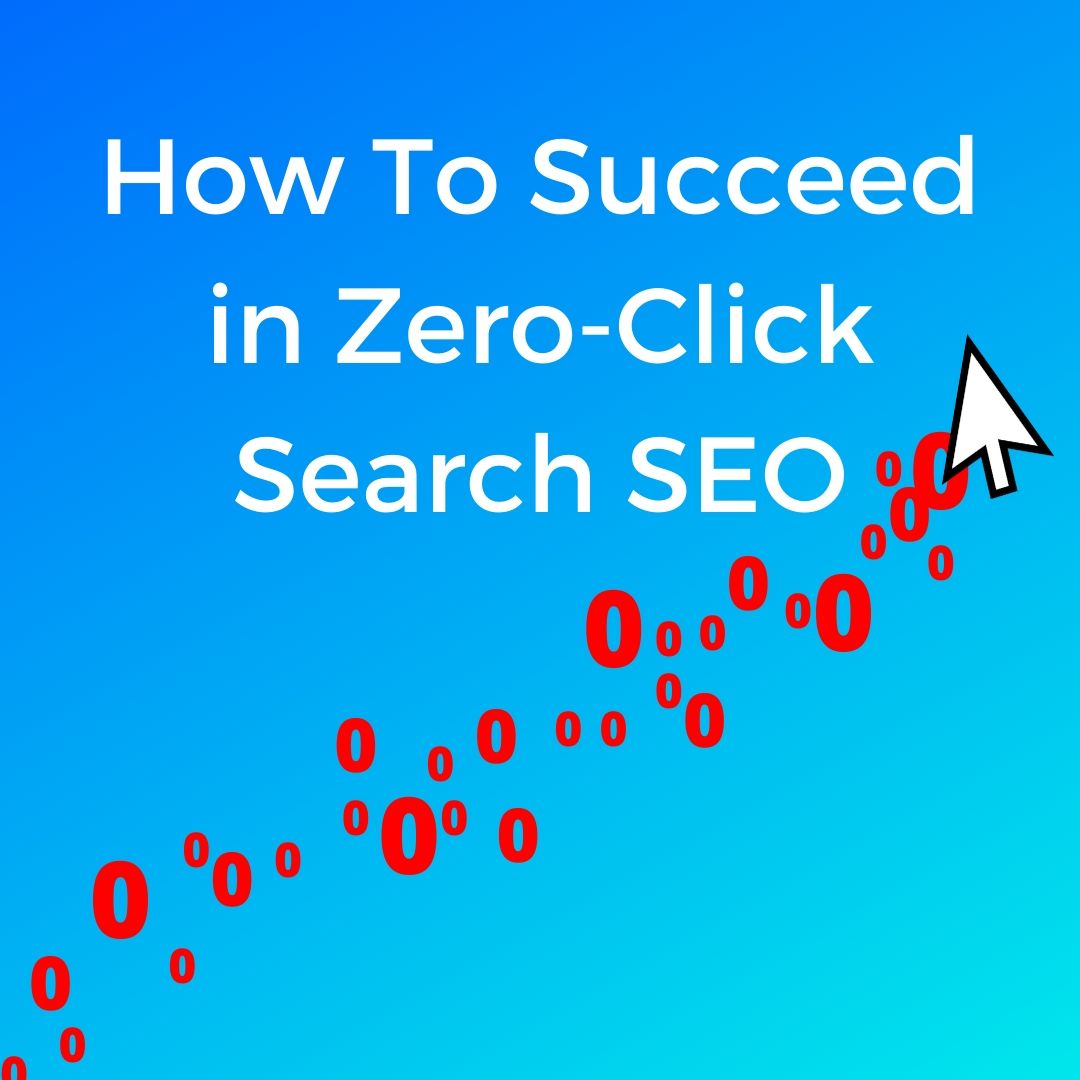
June 17, 2020
How To Succeed in Zero-Click Search SEO
If you’ve landed on our Hawaii SEO Marketing Tips blog by accident while searching for Team Vision Marketing, please visit our homepage, creative portfolio or client video testimonials.
How To Succeed in Zero-Click Search SEO
First of all, what exactly do we mean by Zero-click searches? Zero-clicks means that when people do a Google Search for information, they get the information right on the search results page. They never have to click on any of the organic or paid search results, which means less direct web traffic for your site. As you can imagine, Google realizes that keeping visitors on their SEO results page is of great value (versus having visitors click out to 3rd party web sites), so they are doing everything they can to provide the information people are looking for right there within the search results page. A prime example of this is the expansion of their Google My Business listings over the past couple of years. Visitors searching for your business first see your Google My Business listing which includes your business description, hours of operation, location, phone #, products and services, pricing, and more. For many businesses, such as hotels and attractions, you can also book their offerings right from the Google Search Results page. You get the idea, right? Google is going to keep adding more and more features that keep searchers on their search engine results page. This may eventually make your organic search listing irrelevant.
Last year, about 50% of organic Google searches generated zero clicks. Zero-click searches are on the rise and are causing businesses to receive less impressions, CTRs, and organic web traffic.
According to Spark Toro:
- 34.4% of desktop searches in 2018 resulted in no clicks
- 62.5% of mobile searches produced no clicks in 2018
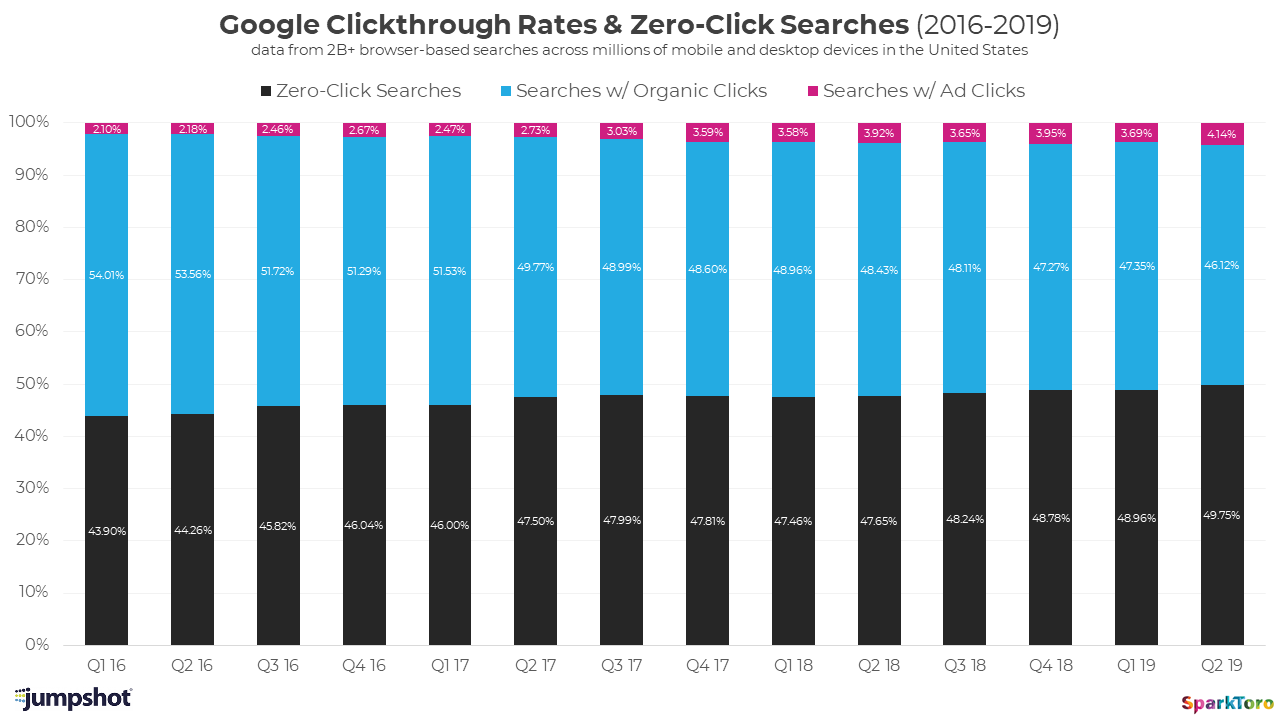
To stay competitive on the coveted first page, Hawaii businesses must adapt their SEO (Search Engine Optimization) marketing to include optimizing their websites for the Zero-Click Google Rich Features, which are effective for spreading brand awareness and positioning your site as a hub of information. In this article, we will share tips on how you can optimize your website to be featured in Rich Features and take back your top SERP glory!
What are Zero-Click Search Rich Features?
Rich Features are blocks of information that help Google users find the answers they are searching for effortlessly. Zero-click search Rich Features provide the answers to a search query, so users don’t have to click through a bunch of websites to find the desired information—hence the name zero click search.
You may have noticed these Rich Features pop up on the SERP in various formats for key phrases, like “Aloha meaning” (see example below). Voice searches using Siri, Alexa, or the Google Assistant read off of these Rich Features when you ask for specific inquiries, like recipes or trivia questions.
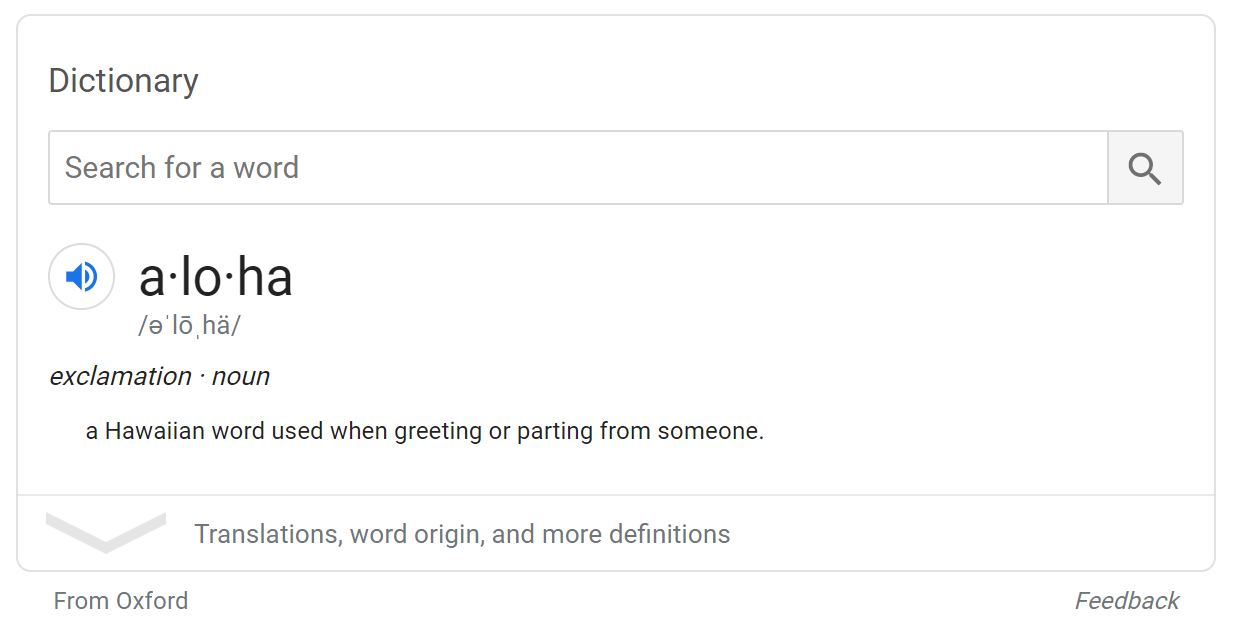
Does That Mean That Zero-Click Rich Features Are Bad For Businesses?
No, zero-click Rich Features can be instrumental in spreading brand awareness and sharing useful information. Rand Fishkin, the founder of SparkToro, said in a Search Engine Land interview that zero-click Rich Features are similar to billboards. Both types of media are hard to collect measurable data but are very useful in building brand familiarity and sharing information.
When Do Zero-Click Searches Or Rich Features Appear On The SERP?
Zero-click searches usually occur for the following types of searches:
- Database Searches
- Dictionary or Encyclopedia Searches
- Map Directions
- Longer tail keyword searches
- Searching for notable people, companies, places, news articles, and more.
- Recipes or “How To” searches
- Asking an FAQ
However, it’s hard to determine which search phrases trigger a Rich Feature to show up. It depends on the search query, the algorithm, and if the other websites on the SERP have optimized their pages for Rich Features. Ahrefs’s report found that only 12.3% of searches produce a Rich Feature. To see the full list of Google Rich Feature formats and where they might appear, click on our previous blog post here.
How Do You Optimize for Zero-Click Rich Features?
First things first….
- Research and list the keywords that show zero-click Rich Features that you currently use in your SEO strategy.
-
- Ahrefs has provided a useful graph of common keywords that are more likely to meet a Rich Feature, see below.
-
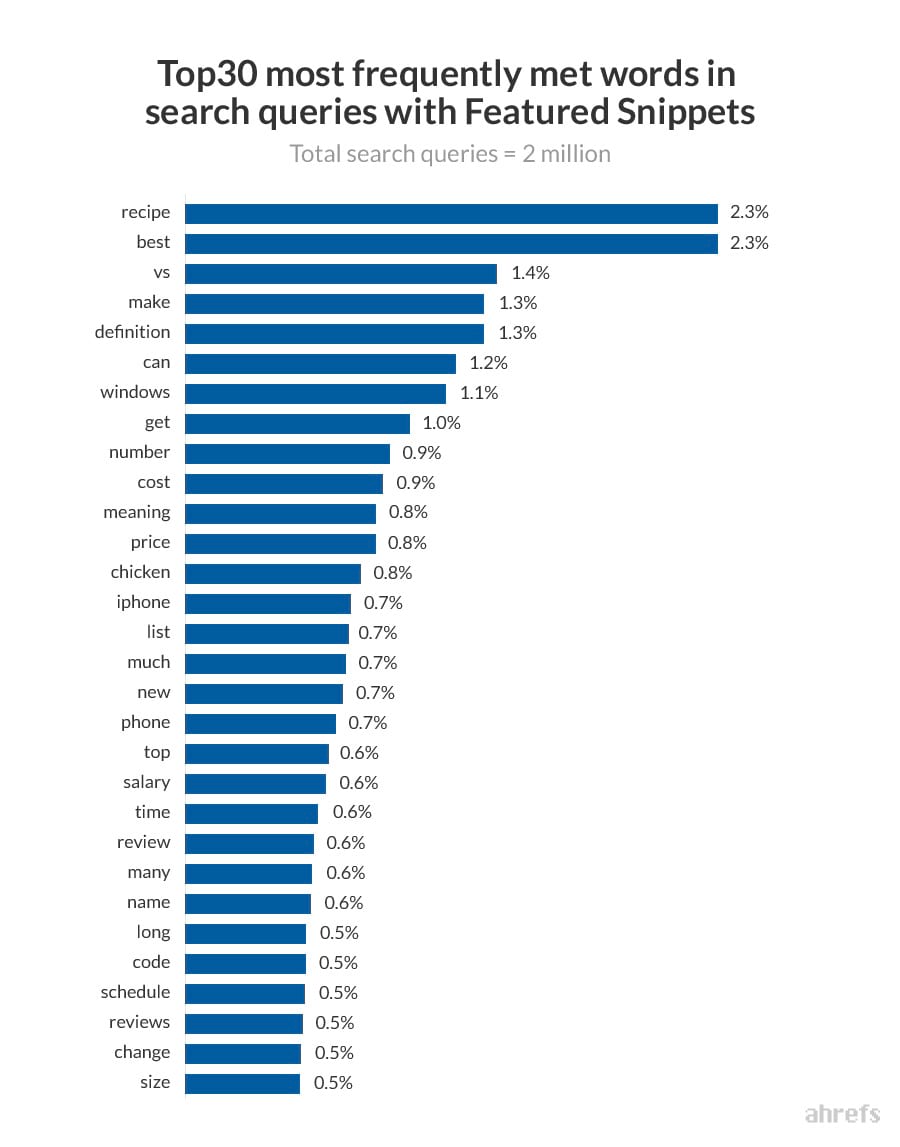
- Identify and optimize the web pages that would work best as a zero-click Rich Feature. You can start by asking yourself:
-
- Can my content define any keywords?
- Do we have a top ten list that’s relevant to a keyword search?
- Do we have any material discussing an in-depth comparison?
- Do we have a step-by-step video tutorial?
-
- Target question-based keywords. Zero-click searches usually appear on question queries. Revise your content so that keyword terms are incorporated in the sub headlines and the precise answer is listed right below it.
-
- You can find inspiration and examples on how to word your questions from existing Rich Features, “People Also Asked” boxes and related searches located at the bottom of the SERP.
-
- Create quality content. Of course, the quality and relevancy of your content will help determine if it will be featured as a Rich Feature.
- Make your content more attractive for Rich Features with schema markups.
-
- Schema markups are microdata that create enhanced descriptions of your content. It helps Google understand your content.
- However, using structured data does not guarantee that your content will show up on the SERP.
-
Now, let’s proceed to our top recommendations for zero-click Rich Features:
How To Optimize For Definitions Rich Features
- Start your first sentence by defining the keyword using verbiage like “[keyword] is a….” or “[keyword] means to….”
- For keywords definitions that require further explanation, organize your content using the inverted triangle method: share the most important and concise information first, important details second, and general information last.
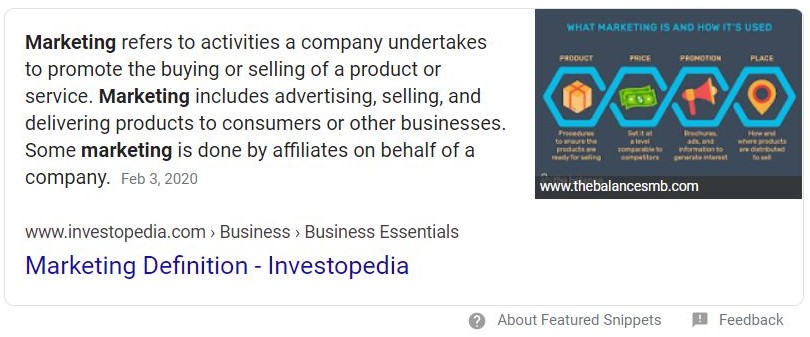
How To Optimize for “People Also Asked” Rich Features
- Sometimes, Google will show alternative questions other users have searched for and provide the answers for them in a dropdown toggle box.
- Write complete questions and answers.
- Use clear, plain language. Google likes to share clear and to-the-point answers.
- Avoid sales language. Remember, people want to find answers to their questions on search, not see promotions.
- Add Q&A schema to your webpages.
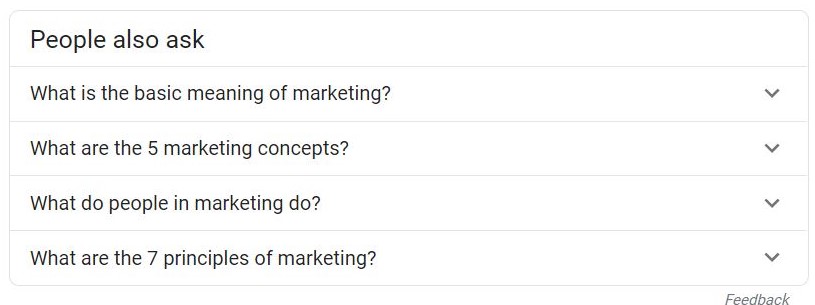
How To Optimize For List Rich Features
- Lists work best for searches that are asking for step-by-step tutorials. For example: “Why is SEO marketing important” or “How to win at zero-click searches.”
- Lists can be unordered (bullet points) or ordered (numbered).
- How you structure your lists is very important. Start a list with a title incorporating the keyword in a question format and make the title H2, H3, etc.
- List major points that relate to the search query and make sure the text is readable and clear.
- It can also work for FAQs and “Top Best” lists
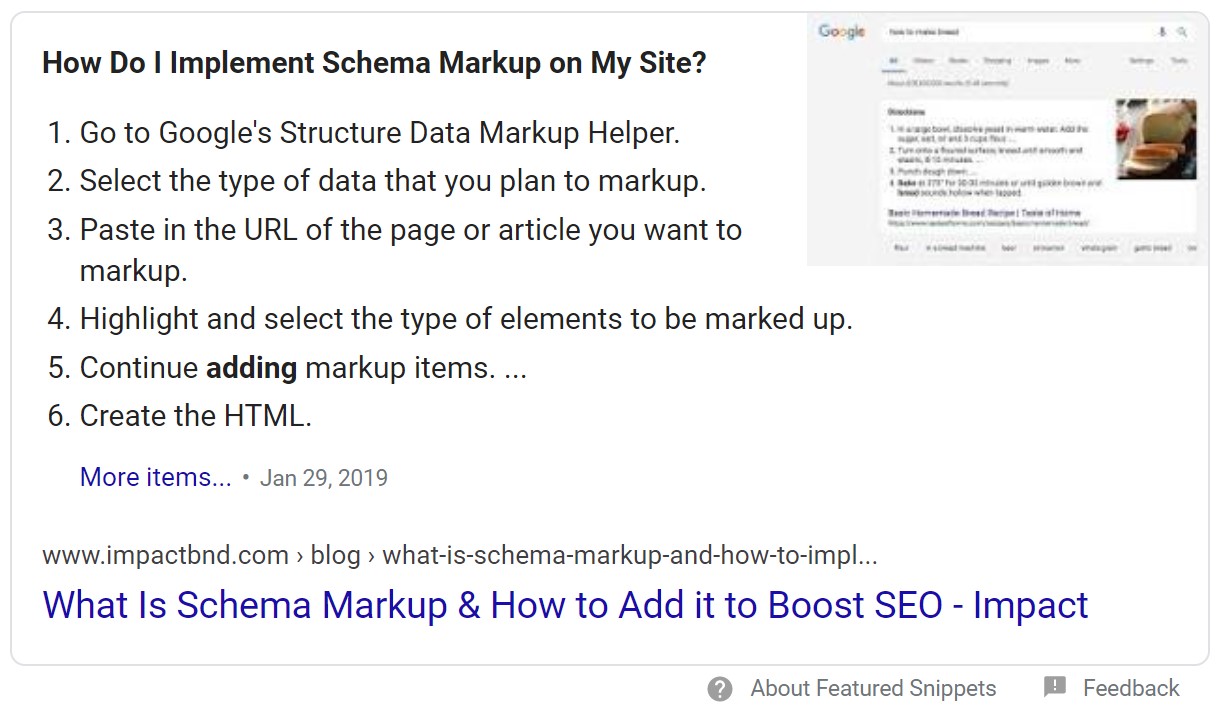
How To Optimize For Comparison Rich Features
- It’s recommended to use tables to map out comparisons. This is because it’s easier for Google to read and searchers to study the pros and cons, or similarities and differences on a topic.
- Similar to how to optimize for a list rich feature, Comparison rich features should have a title incorporating the keyword in a question format above the table and make the title H2, H3, etc.
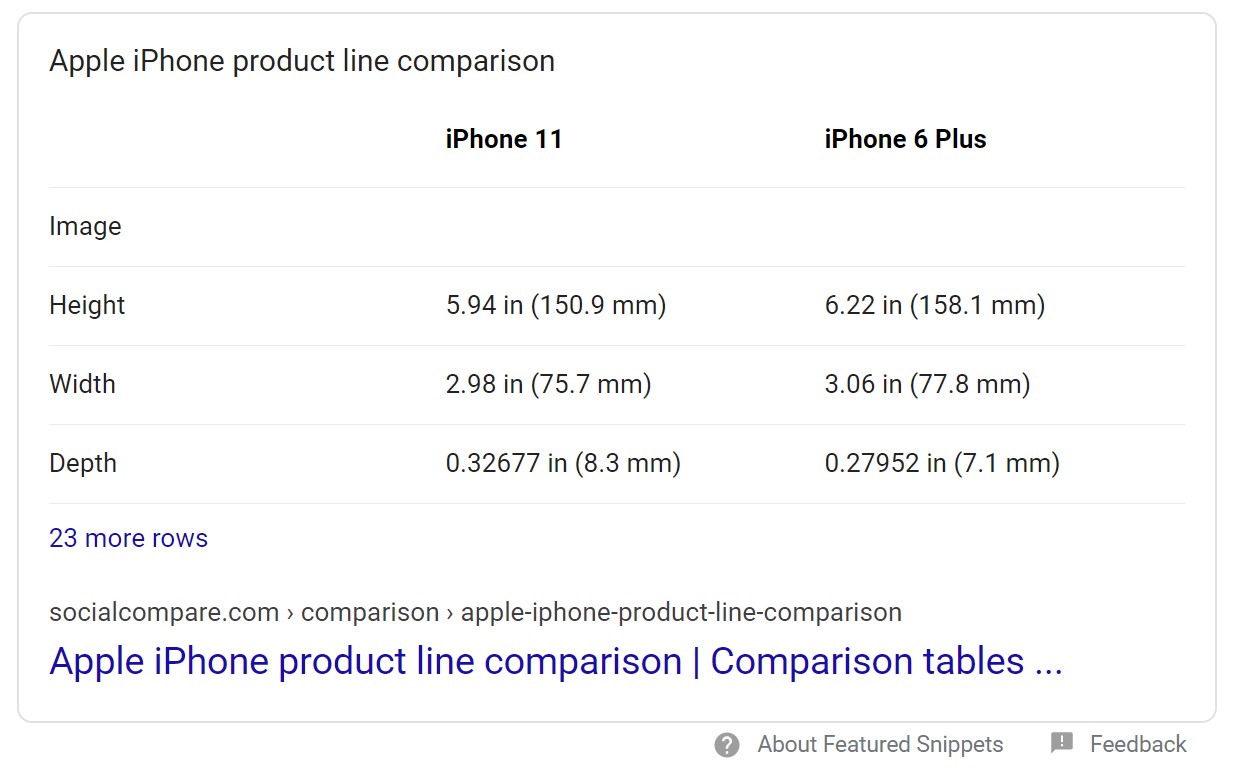
How To Optimize For Image Rich Features
- Google pulls images from different websites to accompany Definition and Text Rich Features.
- To make your images zero-click SEO ready, add alt text that’s a variation of the headline used for the Rich Feature.
- Also, place the image directly under your Rich Feature optimized text or within content, full of relevant keywords.
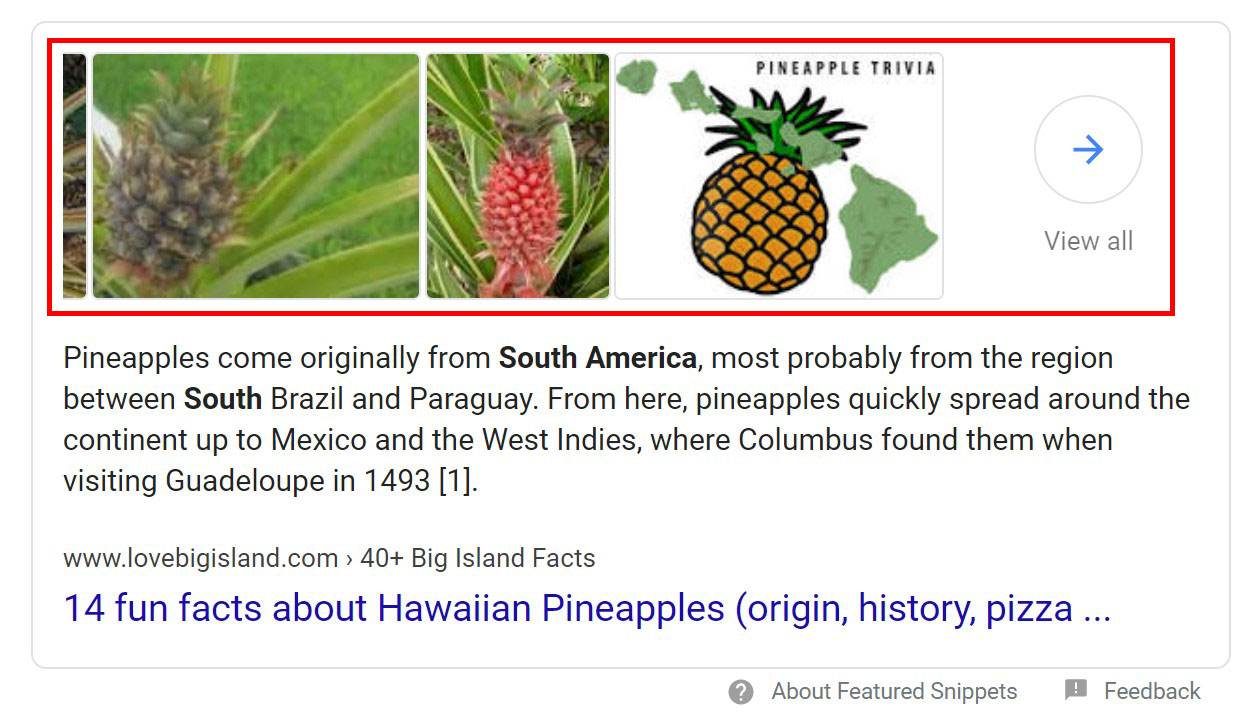
How to Optimize Google Business Listing Rich Feature
- This Rich Feature usually appears on a branded search on the right side of the SERP. It displays your business’s contact information, operation hours, location, reviews, photos, and more.
-
- This Rich Feature is a great way to be displayed on the SERP for branded searches.
-
- To use this Rich Feature, you must claim your business’s listing or create one of your own. Then, optimize it by filling in all the required fields about your business with the most recent information:
-
- Business name
- Hours of operation
- Contact information
- Address
- Photos of your brick-and-mortar store, logo, products
- Additional optimization tips:
-
- Frequently create posts about your products, business, tips, offers, etc.
- Collect Google Reviews
- Answer questions and reply to Google reviews.
-
-
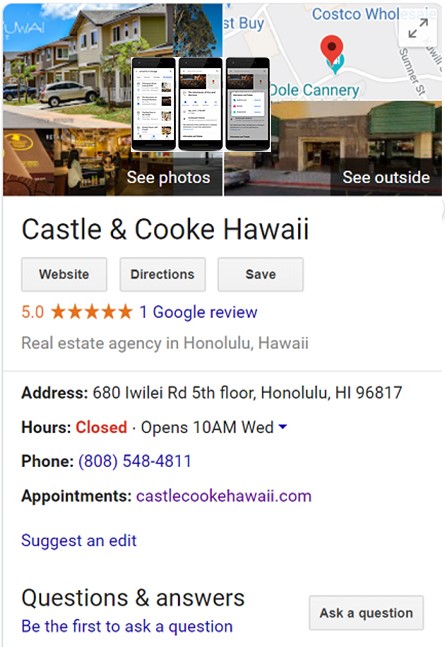
The Takeaway…
With the rise in Zero-Click searches, securing a position on the top of the Google SERP for your Hawaii website has become even more challenging. Although your company will see lower CTRs and organic web traffic, using Google’s Rich Features for Zero-Click Searches can be a valuable organic SEO strategy and it can help generate awareness for your brand and position your website as a credible source of information.
If your Hawaii business needs digital marketing help, please reach out to Team Vision Marketing, Hawaii’s leading advertising and digital marketing agency for over 20 years. We’d love to help!
This is the blog of Team Vision Marketing, a full-service Hawaii advertising agency located in Honolulu, Hawaii and serving clients on Oahu, Maui, Kauai and the Big Island of Hawaii.
Contact Us:
Phone: (808) 536-0416
Email: info@www.teamvision.com
Dolly Moreno, former Director of Sales & Marketing at Honua Kai Resort & Spa on Maui, talks about her experience working with Team Vision Marketing on all of her advertising, graphic design and digital marketing needs.
- How to Select The Best Hawaii Advertising Agency for Your Business
- How AI Will Transform Marketing
- What Is IP Targeting and How Can I Use It for My Business?
- Everything You Need to Know About Instagram’s “Hidden Likes” Test
- Hawaii Social Media Marketing Tips
- How To Succeed in Zero-Click Search SEO
- Social Media Marketing Trends
- Your Guide to Google Rich Search Features
- What to Expect After A Google Broad Core Algorithm Update
- Top 5 Facebook Story Sticker Tips
- Hawaii Search Engine Optimization – SEO Companies
- Top 10 Instagram Story Sticker Tips
- Know The Common Difference: Black Hat SEO vs. White Hat SEO
- 10 Types of Content That Will Boost Engagement
- Video Advertising is Growing – Are You Making the Shift?
- Why You Should Advertise on Facebook Messenger
- Buying Instagram Followers – Is It Worth The Money?
- Top 10 Instagram Hashtag Tips for 2019
- 2018 Social Media Trends: Were We Right On The Money?
- Dreaded Advertising Agency Requests Roundup

